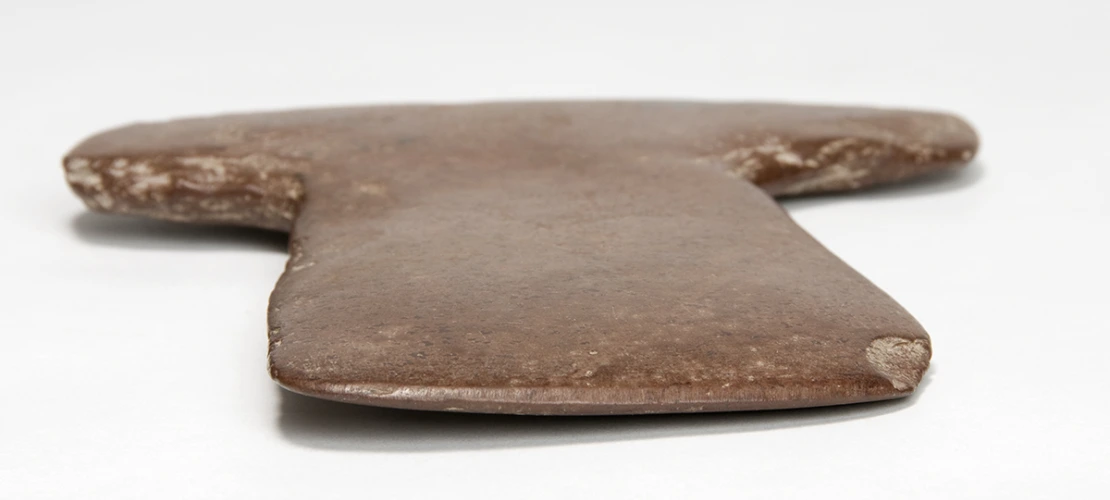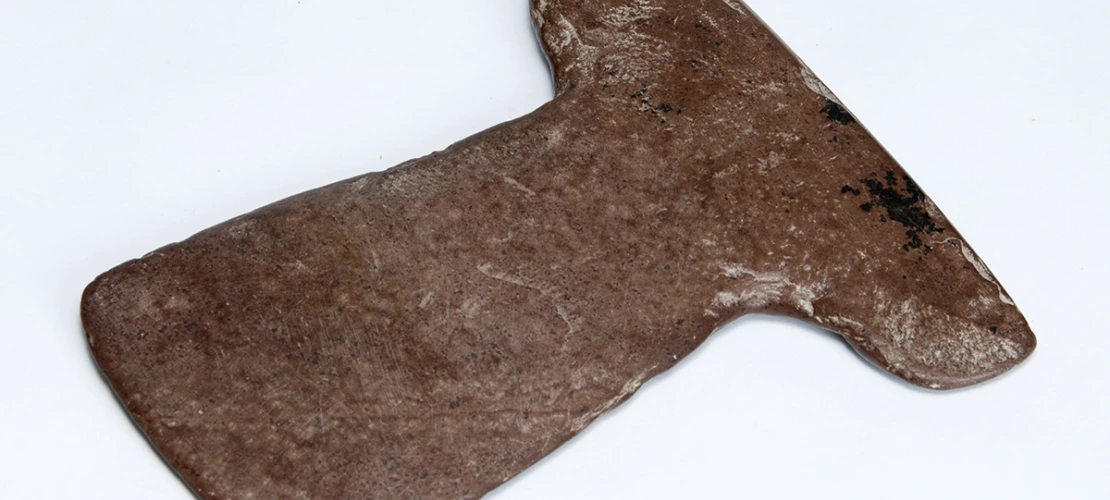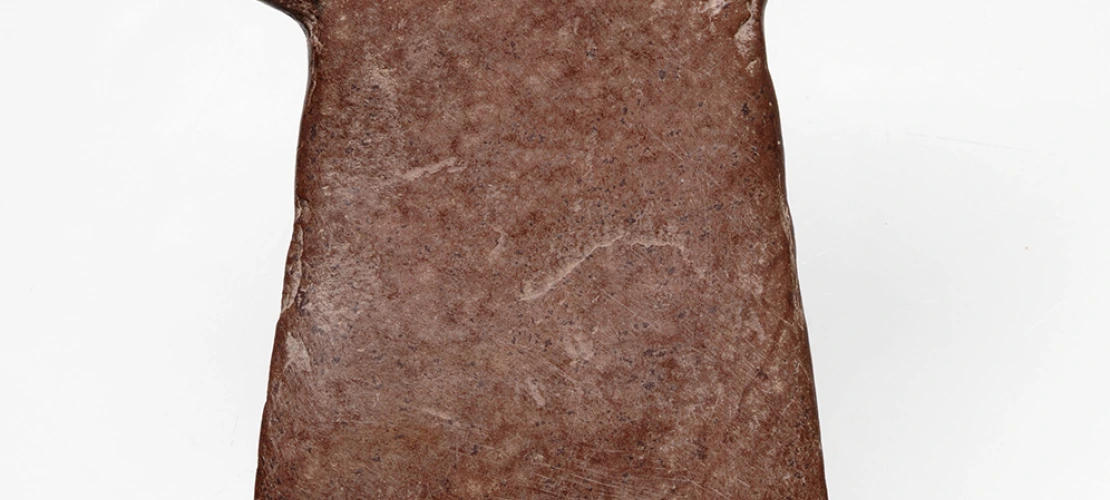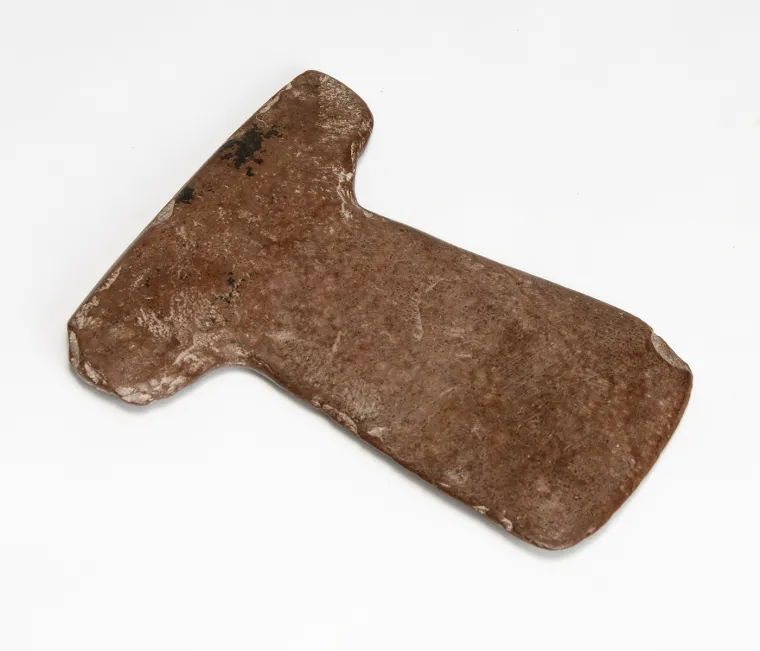
See more of this object in the slideshow below
Agave Scraper
ca. 1150–1275 C.E.
Hohokam
Soza Phase, Classic Period
Flieger Ruin, AZ BB:2:7(ASM)
San Pedro River Valley, Southeastern Arizona
Rhyolite
Length: 6.6 in. (16.8 cm.), Width at handle: 5.6 in. (14.2 cm.), Thickness: 0.6 in. (1.4 cm.)
Gift of Norton Allen and Ethel Allen, 1999
(ASM Catalog No. 99-251-15)
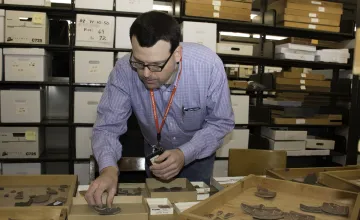
Text by Patrick D. Lyons, Director. August 2013
Beginning in the late 1800s, archaeologists in the U.S. Southwest referred to a class of thin, broad stone artifacts—often made from platy rocks such as slate or schist—as hoes, assuming that such implements were used to prepare and weed ancient agricultural fields.
By the 1960s, researchers began to call these objects “mescal knives” or “agave knives,” having noted that the distribution of these artifacts matched the known range of agave and that native Southwestern peoples had traditionally used similar objects to harvest and process agave for food and fiber. In the 1970s, the term “tabular tool” became popular, reflecting the fact that such artifacts may have been used in a variety of activities.
Based on parallels between some ancient tabular tools and implements used during the early historic period in the Southwest (as well as metal tools used today, in Mexico), archaeologists infer that some of the artifacts previously identified as hoes or knives were used by the Hohokam to remove agave leaves from the core or “heart” of the plant, which was then roasted and eaten. Some of these tools formerly called hoes or knives, however, were actually used as scrapers for removing the thick pulp that surrounds the fibers in agave leaves. Agave fibers, once cleaned of pulp, were dried in the sun and then spun into thread for textiles.
Experiments in agave harvesting and processing by archaeologists and studies of scratches and other indicators of the different motions in which tools were used (chopping, slicing and sawing, scraping) have also provided evidence of the functions of these artifacts. Traces of agave fibers and other tell-tale residues have been found on some of these ancient implements.
Tabular tools with concave working edges were well-designed for removing leaves, but not for scraping pulp. Tools with straight or convex working edges were best for processing leaves for fiber. In some Hohokam households, archaeologists have found toolkits that include tabular tools for removing leaves, tabular tools for pulp removal, and implements used in turning agave fiber into thread, such as spindle whorls.
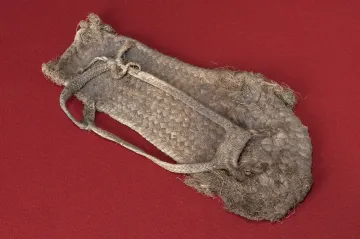
Braided H-strap sandal made of agave fiber. (ASM Catalog No. GP6439)
Not all Hohokam tools used for removing agave pulp were T-shaped. This form, with “built-in” handles, was common in southern Arizona between 950 and 1300 C.E., but other implements used for this task likely consisted of a rectangular blade mounted in a wooden handle like those used by the Otomí of central Mexico. The Otomí employ a wooden-handled scraping tool with a metal blade to extract fiber.
There is evidence to suggest, however, that such tools formerly had stone blades among the Otomí as well as the Aztecs. Stone scrapers the same shape as those referred to as agave knives in the Southwest are frequently recovered in the archaeological sites of central Mexico, where they have been linked to fiber production and are referred to as azadas.
I chose this implement because it is one of the most complete specimens of this type of tool in the Museum’s collections and because it is a great example of how much can be learned from an artifact. Archaeologists have used the distribution of tools like this to investigate household specialization in food and fiber production at different Hohokam villages and even as a way to make inferences about ancient gender roles.
Also, an agave-processing tool illustrates all the different lines of evidence that archaeologists bring to bear when attempting to determine the use of an artifact: ethnographic analogy (determining how living peoples use similar objects), experiments, residue analysis, use-wear studies, and considerations of context (where an object was found and with what it was associated).
ASM received this tool as a gift. It came to the Museum as part of the collection amassed by the late avocational archaeologist, Norton Allen. In the years before historic preservation laws, Mr. Allen excavated Hohokam sites that would have otherwise been destroyed by development. He did this work under the guidance the encouragement of former ASM Director, Emil W. Haury.
References
Printing this page will display URLs for links to citations.
Adams, Jenny L.
- 2002 Ground Stone Analysis: A Technological Approach. University of Utah Press, Salt Lake City.
Bernard-Shaw, Mary
- 1983 The Stone Tool Assemblage of the Salt-Gila Aqueduct Project Sites. In Hohokam Archaeology Along the Salt-Gila Aqueduct Central Arizona Project Volume VIII: Material Culture, edited by Lynn S. Teague and Patricia L. Crown, pp. 373-443. Arizona State Museum Archaeological Series No. 150(8). Arizona State Museum, University of Arizona, Tucson.
- 1990 Experimental Agave Fiber Extraction. In Rincon Phase Seasonal Occupation in the Northern Tucson Basin, by Mary Bernard-Shaw and Frederick W. Huntington, pp. 181-195. Technical Report No. 90-2. Center for Desert Archaeology, Tucson.
Crown, Patricia L., and Suzanne K. Fish
- 1996 Gender and Status in the Hohokam Pre-Classic to Classic Transition. American Anthropologist 98(4):803-817.
Ferg, Alan
- 2003 Traditional Western Apache Mescal Gathering as Recorded by Historical Photographs and Museum Collections. Desert Plants 19(2):1-56.
Ferg, Alan, and Richard A. Schwartzlose
- 2008 Norton Allen, Ernest Allen, and Ethel Allen in Southwestern Arizona and Southern California. In Fragile Patterns: The Archaeology of the Western Papaguería, edited by Jeffrey H. Altschul and Adrianne G. Rankin, pp. 77-103. SRI Press, Tucson.
Fish, Suzanne K., and Marcia Donaldson
- 1991 Production and Consumption in the Archaeological Record: A Hohokam Example. Kiva 56(3):255-275.
Fish, Suzanne K., Paul R. Fish, and John H. Madsen (eds.)
- 1992 Evidence for Large-scale Agave Cultivation in the Marana Community. In The Marana Community in the Hohokam World, edited by Suzanne K. Fish, Paul R. Fish, and John H. Madsen, pp. 73-87. Anthropological Papers of the University of Arizona No. 56. University of Arizona Press, Tucson.
Fish, Suzanne K., Paul R. Fish, and John H. Madsen (eds.)
- 1992 The Marana Community in the Hohokam World. Anthropological Papers of the University of Arizona No. 56. University of Arizona Press, Tucson.
Fish, Suzanne K., Paul R. Fish, Charles Miksicek, and John Madsen
- 1985 Prehistoric Agave Cultivation in Southern Arizona. Desert Plants 7(2):107-112, 100.
Greenwald, Dawn
- 1988 Ground Stone. In Hohokam Settlement Along the Slopes of the Picacho Mountains: Material Culture, Tucson Aqueduct Project, edited by Martha M. Callahan, pp. 127-220. Museum of Northern Arizona Research Paper No. 35(4). Museum of Northern Arizona, Flagstaff.
Gregonis, Linda M., and Karl J. Reinhard
- 1979 Hohokam Indians of the Tucson Basin. University of Arizona Press, Tucson.
Huntington, Frederick W.
- 1986 Ground Stone and Miscellaneous Artifacts. In Archaeological Investigations at the West Branch Site: Early and Middle Rincon Occupation in the Southern Tucson Basin, by Frederick W. Huntington, pp. 251-272. Anthropological Papers No. 5. Institute for American Research, Tucson.
Kisselburg, JoAnn E.
- 1987 Economic Specialization in the Community System at Marana. In Studies in the Hohokam Community of Marana, edited by Glen E. Rice, pp. 143-159. Anthropological Field Studies No. 15. Office of Cultural Resource Management, Department of Anthropology, Arizona State University, Tempe.
Parsons, Jeffrey R. and Mary H. Parsons
- 1990 Maguey Utilization in Highland Central Mexico: An Archaeological Ethnography. Anthropological Papers No. 82. Museum of Anthropology, University of Michigan, Ann Arbor.
Rice, Glen E.
- 1987 Floor Assemblages of the Marana Community Complex. In Studies in the Hohokam Community of Marana, edited by Glen E. Rice, pp. 79-141. Anthropological Field Studies No. 15. Office of Cultural Resource Management, Department of Anthropology, Arizona State University, Tempe.






